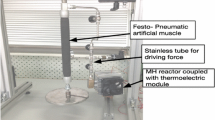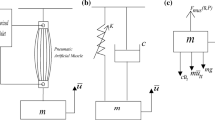Abstract
Quantitative understanding of mechanical actuation of intricate Pneumatic Artificial Muscle (PAM) actuators is technically required in control system design for effective real-time implementation. This paper presents mathematical modeling of the PAM driven by hydrogen-gas pressure due to absorption and desorption of metal hydride. Empirical models of both mechanical actuation of industrial PAM and chemical reaction of the metal hydride-LaNi5 are derived systematically where their interactions comply with the continuity principle and energy balance in describing actual dynamic behaviors of the PAM actuator (PAM and hydriding/dehydriding-reaction bed). Simulation studies of mechanical actuation under various loads are conducted so as to present dynamic responses of the PAM actuators. From the promising results, it is intriguing that the heat input for the PAM actuator can be supplied to, or pumped from the reaction bed, in such a way that absorption and desorption of hydrogen gas take place, respectively, in controlling the pressure of hydrogen gas within the PAM actuator. Accordingly, this manipulation results in desired mechanical actuation of the PAM actuator in practical uses.
Similar content being viewed by others
Abbreviations
- A:
-
Coefficient of polynomial function
- c0, c1:
-
Constant coefficients of PAM geometry
- cp, H:
-
Specific heat at constant pressure of hydrogen
- cp, La:
-
Specific heat at constant pressure of lanthanum
- cp, MH:
-
Specific heat at constant pressure of metal hydride
- cp, Ni:
-
Specific heat at constant pressure of nickel
- cv, H2:
-
Specific heat at constant volume of hydrogen gas
- Ca, Cd:
-
Material-dependent constants for absorption and desorption, respectively
- Ea, Ed:
-
Activation energy of absorption and desorption, respectively
- F:
-
Pulling force
- ΔH:
-
Reaction heat of formation; absorption or desorption
- I:
-
Index of polynomial order
- L:
-
Instantaneous length of PAM
- Ls:
-
Stretched length
- Lu:
-
Unstretched length
- K:
-
Stiffness parameter of PAM
- mH:
-
Mass of hydrogen atom
- mMH:
-
Mass of metal hydride
- mH,sat:
-
Saturated mass of hydrogen atom
- \(m_{H_{2}}\) :
-
Mass of hydrogen gas
- ṁf:
-
Hydride formation rate
- MH:
-
Atomic mass of hydrogen
- \(M_{H_{2}}\) :
-
Molecular moles of hydrogen gas
- MLa:
-
Atomic mole of lanthanum
- MMH:
-
Molecular mass of metal hydride
- MNi:
-
Atomic mole of nickel
- n:
-
Highest order of polynomial function
- P:
-
Absolute pressure
- Ṗ:
-
Rate of change in pressure
- Peq:
-
Equilibrium pressure
- Pg:
-
Gauge pressure within PAM
- Q̇:
-
Rate of heat transfer to reaction bed
- r:
-
Equivalent radius
- \(R_{H_{2}}\) :
-
Gas constant of hydrogen gas
- Rg:
-
Universal gas constant
- xH/MH:
-
Hydrogen-to-metal atomic ratio
- t:
-
Time
Refereces
Kao P, Lewis C L, Ferris D P. Invariant ankle moment patterns when walking with and without a robotic ankle exoskeleton. Journal of Biomechanics, 2010, 43, 203–209.
Cullell A, Moreno J C, Rocon E, Forner-Cordero A, Pons J L. Biologically based design of an actuator system for a knee-ankle-foot orthosis. Mechanism and Machine Theory, 2009, 44, 860–872.
Wickramatunge K C. Modeling and Control of Pneumatic Artificial Muscle Actuator, MS thesis, Thammasat University, Hua Hin, Thailand, 2008.
Lioyd G M, Kim K J, Razani A, Shahinpoor M. Investigation of a solar-thermal bio-mimetic metal hydride actuator. ASME Journal of Solar Energy Engineering, 2003, 125, 95–100.
Vanderhoff A, Kim K J. Experimental study of a metal hydride driven braided artificial pneumatic muscle. Journal of Smart Materials and Structures, 2009, 18, 125014.
Ino S, Sato M. A novel soft actuator using metal hydride materials and its applications in quality-of-life technology, in New Developments in Biomedical Engineering, Domenico Campolo (Ed.), InTech, Charlotte, NC, USA, 2010, 499–515.
Ino S, Sato M, Hosono M, Izumi T. Development of a soft metal hydride actuator using a laminate bellows for rehabilitation systems. Sensors and Actuators: B. Chemical, 2009, 136, 86–91.
Kim J, Park I, Kim K J, Gawlik K. A hydrogen-compression system using porous metal hydride pellets of LaNi5−xAlx. International Journal of Hydrogen Energy, 2008, 33, 870–877.
Wickramatunge K C, Leephakpreeda T. Study on mechanical behaviors of pneumatic artificial muscle. International Journal of Engineering Science, 2010, 48, 188–198.
Askri F, Jemni A, Nasrallah S B. Prediction of transient heat and mass transfer in a closed metal-hydrogen reaction bed. International Journal of Hydrogen Energy, 2004, 29, 195–208.
Dhaou H, Askri F, Salah M B, Jemni A, Nasrallah S B, Lamloumi J. Measurement and modeling of kinetics of hydrogen sorption by LaNi5 and two related pseudobinary compounds. International Journal of Hydrogen Energy, 2007, 32, 576–587.
Mat M D, Kaplan Y. Numerical study of hydrogen absorption in a LaNi5 hydride bed. International Journal of Hydrogen Energy, 2001, 26, 957–963.
Førde T, Næss E, Yartys V A. Modelling and experimental results of heat transfer in a metal hydride store during hydrogen charge and discharge. International Journal of Hydrogen Energy, 2009, 34, 5121–5130.
Yang F, Meng X, Deng J, Wang Y, Zhang Z. Identify heat and mass transfer characteristics of metal hydride reactor during adsorption-parameter analysis and numerical study. International Journal of Hydrogen Energy, 2008, 33, 1014–1022.
Laurencelle F, Goyette J. Simulation of heat transfer in metal hydride reactor with aluminum foam. International Journal of Hydrogen Energy, 2007, 32, 2957–2964.
Author information
Authors and Affiliations
Corresponding author
Rights and permissions
About this article
Cite this article
Leephakpreeda, T. Mathematical Modeling of Pneumatic Artificial Muscle Actuation via Hydrogen Driving Metal Hydride-LaNi5. J Bionic Eng 9, 110–118 (2012). https://doi.org/10.1016/S1672-6529(11)60103-0
Published:
Issue Date:
DOI: https://doi.org/10.1016/S1672-6529(11)60103-0




